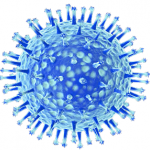transmission
I've been asked several times about this NY Post article on the CDC's "admission" that a sneeze could spread Ebola. The Post (which, I should note, is the least credible newspaper in New York City, for those not familiar with the paper) suggests that the CDC has changed their tune regarding the spread of Ebola.
Except, they haven't, and this is a ridiculous, trumped-up non-story, passed along not only by the Post but by others of the typical suspects like conspiracy theorist extraordinaire Mike Adams, aka "The Health Ranger" of Natural News.
Here's what the NY Post claims:
“Droplet spread…
Since yesterday's post, several people have asked me on various social media outlets about the airborne nature of Ebola. Didn't I know about this paper ("Transmission of Ebola virus from pigs to non-human primates"), which clearly showed that Ebola could go airborne?
Indeed I do--I wrote about that paper two years ago, and it in no way changes my assertion that Ebola doesn't spread between people in an airborne manner.
Let me back up. The paper in question was an experimental study done in the wake of the 2008 finding of the Reston Ebola virus in pigs and a previous study looking at…
Student guest post by Sean McCaul
Image Source: http://www.cejournal.net/?p=1934
The next time somebody in your office or household has the flu, you might want to consider keeping your distance. A new study published this month in Nature Communications suggests that about half of the transmission of influenza A results from inhalation of microscopic infectious droplets created by the coughing and sneezing of people infected with the flu. The flu virus hitches a ride in these droplets, and may infect nearby susceptible people who breathe them in.1
The influenza A virus…
Ebola has long been known to be a zoonotic virus--one which jumps between species. Though it took several decades to find evidence of Ebola virus in bats, these animals had previously been associated with human index cases of Ebola disease have worked in bat-infested warehouses or traveled to caves where bats roost. Non-human primates have also become infected with the virus, sometimes transmitting the virus to humans when killed primates are butchered for food. Ebola has also been suggested to infect dogs and other wild animals. However, livestock are a newer angle to Ebola virus ecology.…
Here is a picture of something you have seen before.
These are two pictures of the same location in my house. The one on the left is taken when the Sun was up outside and the other one when it was dark outside. For both pictures, I had the same lights turned on inside. So, why does it do this? Why can you see stuff outside when it is bright outside, but you don't see a reflection of the stuff outside? Why when it is dark outside, does the opposite happen? You know what I am going to do next, right? Diagram. Here is a diagram for when it is dark outside.
The person can see the blue…
Prions are proteins that have become bent out of shape. Their chain of amino acids folds up in an abnormal ways, and they can transmit this rogue alignment to their normal counterparts. As their numbers increase, they gather in large clumps that can kill neurons and damage brains. They most famously cause BSE in cows, CJD in humans and scrapie in sheep. But other mammals suffer from prion diseases too - the deer equivalent is called chronic wasting disease or CWD and it is shedding light on how prions are transmitted in the wild.
Gultekin Tamguney from the University of California,…
